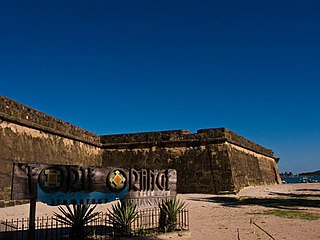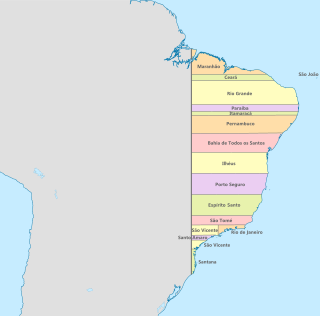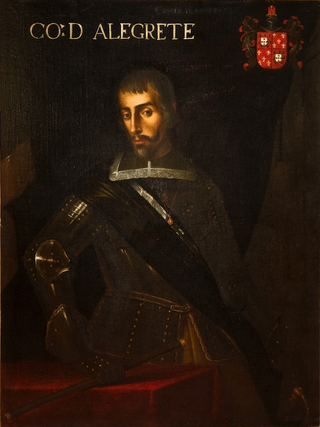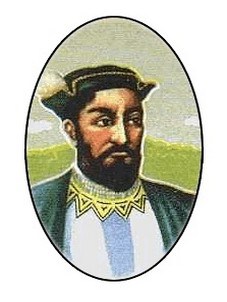
Pernambuco is a state of Brazil located in the Northeast region of the country. With an estimated population of 9.5 million people as of 2024, it is the seventh-most populous state of Brazil and with around 98,067.877 km2, it is the 19th-largest in area among federative units of the country. It is also the sixth-most densely populated with around 92.37 people per km2. Its capital and largest city, Recife, is one of the most important economic and urban hubs in the country. Based on 2019 estimates, the Recife Metropolitan Region is seventh-most populous in the country, and the second-largest in northeastern Brazil. In 2015, the state had 4.4% of the national population and produced 2.8% of the national gross domestic product (GDP).

Ilha de Itamaracá is a tropical island and municipality in Pernambuco, Brazil on the Atlantic Ocean. Itamaracá means "stone shaker" in Tupi, from the words itá ("stone") and mbara'ká ("shaker"). It is separated from the mainland by the Canal de Santa Cruz, a salt water channel both mouths of which are on the Atlantic Ocean, and is connected to the mainland by a long road bridge.

Colonial Brazil comprises the period from 1500, with the arrival of the Portuguese, until 1815, when Brazil was elevated to a kingdom in union with Portugal. During the 300 years of Brazilian colonial history, the main economic activities of the territory were based first on brazilwood extraction, which gave the territory its name; sugar production ; and finally on gold and diamond mining. Slaves, especially those brought from Africa, provided most of the workforce of the Brazilian export economy after a brief initial period of Indigenous slavery to cut brazilwood.

Camaragibe is a city in the Northeast region of Brazil, in the state of Pernambuco. It lies within the Greater Recife — Brazil's 5th-largest metropolitan area.

The Captaincies of Brazil were captaincies of the Portuguese Empire, administrative divisions and hereditary fiefs of Portugal in the colony of Terra de Santa Cruz, later called Brazil, on the Atlantic coast of northeastern South America. Each was granted to a single donee, a Portuguese nobleman who was given the title captain General.

Gilberto de Mello Freyre was a Brazilian sociologist, anthropologist, historian, writer, painter, journalist and congressman born in Recife. Considered one of the most important sociologists of the 20th century, his best-known work is a sociological treatise named Casa-Grande & Senzala.

Igarassu is a city in the Brazilian state of Pernambuco. It is the second oldest city of the country and is situated on the north coast of the metropolitan region of Recife, approximately 32 kilometres (20 mi). It stands as one of the earliest European settlements in Brazil and is the site of the oldest church in the country, the Church of Saints Cosme and Damião, built in 1535. Igarassu is home to numerous colonial-period historic structures. The historic center of the city was designated a national monument by the National Institute of Historic and Artistic Heritage (IPHAN) in 1972.

Dutch Brazil, also known as New Holland, was a colony of the Dutch Republic in the northeastern portion of modern-day Brazil, controlled from 1630 to 1654 during Dutch colonization of the Americas. The main cities of the colony were the capital Mauritsstad, Frederikstadt, Nieuw Amsterdam (Natal), Saint Louis, São Cristóvão, Fort Schoonenborch (Fortaleza), Sirinhaém, and Olinda.

The Capibaribe River is a river located in Pernambuco state, Brazil, with a length of 240 kilometers. The Capibaribe originates in the Serra do Jacarará, in the municipality of Poção, and flows to the Atlantic Ocean at Recife.

Before the arrival of the Europeans, the lands that now constitute Brazil were occupied, fought over and settled by diverse tribes. Thus, the history of Brazil begins with the indigenous people in Brazil. The Portuguese arrived to the land that would become Brazil on April 22, 1500, commanded by Pedro Álvares Cabral, an explorer on his way to India under the sponsorship of the Kingdom of Portugal and the support of the Catholic Church.

José Abelardo Barbosa de Medeiros, better known as Chacrinha, was a Brazilian comedian, radio and TV personality. His career was at its peak from 1950 to 1980. He was author of a famous Brazilian phrase that states: "Na televisão, nada se cria, tudo se copia". Famous Brazilian celebrities made their debut on his show, such as Roberto Carlos and Raul Seixas.

Matias de Albuquerque, Count of Alegrete was a Portuguese colonial administrator and soldier. He was nicknamed "Hero of Two Continents" for his performance, beginning in 1624, against the Dutch invaders of colonial Brazil and for his role, beginning in 1641, as a general in Portugal, fighting for king John IV during the Portuguese Restoration War, where he won the battle of Montijo over the Spaniards in 1644. For this victory he was rewarded the title of Count of Alegrete by the king.

The siege of Recife was a battle between Dutch and Portuguese forces near modern-day Recife, Brazil, in 1630.

The War of the Mascates might be more accurately called an insurrection; the main events occurred in and around Recife, Pernambuco during 1710 and 1711. Some consider the underlying causes lasted for two centuries. The two sides were the landed elites, often referred to as senhores de engenho, and the merchants of Recife.

Duarte Coelho Pereira was a nobleman, military leader, and colonial administrator in the Portuguese colony of Brazil. He was the first Donatario of the captaincy of Pernambuco and founder of Olinda.

The Captaincy of Pernambuco or New Lusitania was a hereditary land grant and administrative subdivision of northern Portuguese Brazil during the colonial period from 1534 to 1821, with a brief interruption from 1630 to 1654 when it was part of Dutch Brazil. At the time of the Independence of Brazil, it became a province of United Kingdom of Portugal, Brazil and the Algarves. Captaincies were originally horizontal tracts of land (generally) 50 leagues wide extending from the Atlantic Ocean to the Tordesillas meridian.

The Capture of Recife also known as James Lancaster's 1595 Expedition or Lancaster's Pernambucan expedition was an English military expedition during the Anglo–Spanish War in which the primary objective was the capture of the town and port of Recife in the Captaincy of Pernambuco in the Portuguese colony of Brazil in April 1595. An English expedition of ships led by James Lancaster sailed via the Atlantic capturing numerous prizes before he captured Recife. He held the place for nearly a month and then proceeded to defeat a number of Portuguese counterattacks before leaving. The booty captured was substantial, Lancaster chartered Dutch and French ships that were also present there thus making the expedition a military and financial success.
The following is a timeline of the history of the city of Recife, Pernambuco, Brazil.
Jerónimo de Albuquerque was a Portuguese nobleman, military leader, and colonial administrator in the Portuguese Captaincy of Pernambuco, Brazil.

The 1937 Brazilian coup d'état, also known as the Estado Novo coup, was a military coup in Brazil led by President Getúlio Vargas with the support of the Armed Forces on 10 November 1937.


























